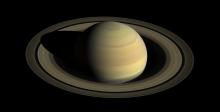Listen to today's episode of StarDate on the web the same day it airs in high-quality streaming audio without any extra ads or announcements. Choose a $8 one-month pass, or listen every day for a year for just $30.
You are here
Autumn
The Sun rises in the east and sets in the west. That’s common knowledge. But it’s also a bit imprecise. Unless you live along the equator, the Sun rises due east and sets due west only twice a year — at the equinoxes. The rest of the time, it can swing well north and south of those points.
And today is the autumnal equinox — the beginning of autumn in the northern hemisphere.
The sunset and sunrise points change because Earth is tilted on its axis — which is also why we have seasons. At the summer solstice, in June, the north pole is tilted most directly toward the Sun. The northern hemisphere gets lots of sunlight, so it’s the start of summer. And at the winter solstice, in December, the south pole tips sunward, so the southern hemisphere is in the light.
On the equinoxes, the Sun appears to stand directly above the equator. So there’s roughly equal sunlight north and south of it.
Over the course of a year, then, the Sun moves north and south along the horizon — farthest north in summer, farthest south in winter. And on the equinoxes, it’s between those extremes. So it rises due east and sets due west.
As we head toward the winter solstice, in December, the Sun will move ever southward. How much it will move depends on your latitude. It makes a much more dramatic swing for those at higher latitudes. So those in Spokane and Duluth will see the Sun move more than those in Miami and San Antonio — a motion caused by the changing seasons.
Script by Damond Benningfield






